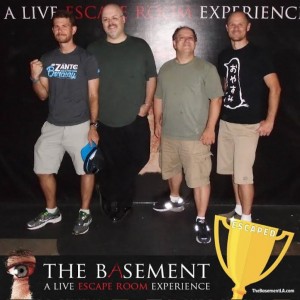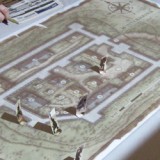The Boiler Room
The direct sequel to The Basement, the Boiler Room, is also an escape room, but with a twist. I think it’s a good example of how the genre can be altered and modified to create different experiences, while still retaining the same tension and excitement of a more standard escape room.
So how is the Boiler Room different? It’s small. Really small. After failing to escape the Basement, the story goes, we wake up in the serial killer’s Boiler Room while he prepares to eat us. But this time…the room is only about 5 feet by 5 feet, and there are only 4 people inside. Any more than four, and it would be difficult to move around in the tiny space. There are very few objects, although there is some writing on the walls. There is so little to go on; how can we possibly get out?
Remember this line from my previous review?
[E]veryone scattered to various sections of the room, as is typical at the start of these rooms.
I’m bringing it back here to show that this room is definitely not typical. There was no scattering–there was no room to go anywhere, and not enough clues to split up! It turned out to be a linear room, as opposed to the free-form openness of the Basement. You must solve the puzzles here in a certain order before getting enough information to move on. So the lack of information is real–and necessary. One would think that with only one puzzle to be worked on at a time, that each player would see everything. That wasn’t quite the case for my team, although it was partially by choice. I saw the clues to the first puzzle and had a good idea of how it would go, but I didn’t pay attention as my teammates solved it. I was already looking ahead to the second puzzle (which, of course, I did not have enough information for).
Where the Basement specialized in spooky atmosphere, this time the best feature is the interactive technology and props. It wasn’t scary like the Basement. The lighting was bright; there was nothing grisly or gruesome, which made for a different mindset. The best part of this room was the cool stuff that was implemented in a more physical manner. It would be a crime to give away some of the surprises of this room, but I think it’s ok to say a 5×5 room IS too small, and you may discover other areas that are not immediately visible. This physical interaction adds so much fun to escape rooms that I really hope it becomes a trend. Standing around a table punching in codes is fun, but it doesn’t hold a candle to…well, what we had to do to escape the Boiler Room. :)
And escape we did! This room has a 35 minute time limit, 10 minutes shorter than the Basement, yet the four of us got out with about 13 minutes to spare. Yet it’s rated harder than the Basement (which we failed) on their website. When we asked the staff, they explained that some people really have trouble with the linear style of room and work better when they can divide their attention. Personally, I think this one is a great introductory room that helps focus the team together on one problem at a time. Even though it’s the sequel, I wouldn’t have any qualms about recommending this room to people who haven’t done the Basement, with one caveat; your team should have at least one person who is reasonably flexbile/physical. Mysterious, right? Since they are in the same location, the Boiler Room is also open Wednesday through Sunday and have availability as late as 1:10 am on weekends. Videos, reservations, directions, and more can all be found at their website, www.thebasementla.com



















